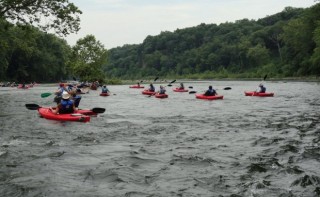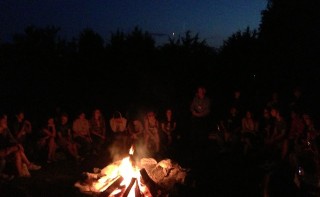Sc3 was organized by the Green Schools Alliance, a global network of schools representing two million students pledging to make their communities greener. It brought together 107 high school students from all over the country for a week at the National Conservation Training Center of the U.S. Fish & Wildlife Service in Shepherdstown, West Virginia. Hannah S., Côme L. and I from the Lycée attended the Congress.
What I did
On the night of our arrival, we were welcomed by radio show host/comedian and environmentalist Pete Dominick. During his speech, he explained to us that throughout the week we faculty, students and speakers, should come together to brainstorm and learn. His words inspired us all week long.
Two days later, Dr. Bob Pyle, lepidopterist and field biologist spoke to us about the declining diversity of butterfly species, and he also shared with us possible solutions to reverse this effect. His passion about these tiny creatures was contagious and very inspiring to watch. We might not have all shared in his dedication for butterflies, but we were ready to tap into the passion Dr. Pyle radiated before us. From then on, throughout the week, we were introduced to many experts in their own fields: National Geographic wildlife photographer, Joe Riis, who photographed the rarest bear in the world in Mongolia; Carl Safina, host of the PBS series Saving the Ocean, who documented marine environments around the world; and Dr. Mitchell Joachim, who an architect of sustainable designs for the future.
We also had what were called “Open Space Technology” sessions where we were in charge of the discussions. Whatever came to mind would be blurted out, giving way to an open dialogue between anyone who wanted to participate. We brainstormed our own topics – Land Ethics; Reduce, Reuse, Recycle; Education; Wildlife Conservation — and were free to leave one conversation and join another. At the end of each session, we were to come up with a “deliverable” — a long-term project we were asked to bring back to our schools in the hopes of making an impact in each of our communities. In the Wildlife Conservation Group, we decided to bring back nine presentations, one for every month of the school year, to present to our community to educate and change people’s thinking and understanding.
What I learned
I went into the program hoping that some guy with a PowerPoint presentation would tell me “we’re all going to die if we don’t do this, this and this.” I thought that only a sense of doom would get me and others to change our ways. Thankfully, though, Sc3 got me to foster my own passion for the environment with a different message. I found the same passion the leaders felt every day. We weren’t being told what to do. Rather, we were speaking with them and deciding together what we’d do.
The concept of collaboration spoke volumes to me. We had workshops with leaders from the Navajo Native-American community, some of whom were students participating in the congress. During a campfire session, they showed us how their community connected with nature and how it was an element to preserve and treat as if it were a family member. In some sense I took that to heart, and it changed my thinking and experience in nature. For example, when I saw the fireflies glimmering through the shrubs, I saw nature. Right at the beginning, we took a two-and-a-half kayaking trip down the Potomac River. We all shrieked upon finding a daddy long legs crawling up the side of our arms, and I (quite literally) communed with nature. When we spent nights around the camp fire, making s’mores and embracing the heat of the fire, I felt nature.
After watching a performance by Travis Book, a singer in the Grammy-nominated blue-grass group The Infamous Stringdusters, we were privileged to have a Q&A with him. We asked him the best advice he could give us. He told us two things: listen to the actual force of nature, and always respond with a ‘yes’ before ‘no’. After our discussion with Navajo people and connecting with nature on my own on the trip, I began to understand what he meant.
The Sc3 conference changed my thinking. One week to meet 107 people was at first a pretty overwhelming concept to wrap our heads around. One week to trade in our artificial city dwellings for the as-of-yet unspoiled banks of the Potomac River was staggering as well. However, the overwhelming nature of the week — a surplus of emotion, of fear, and of excitement, contributed to the passion that every person participating in this congress felt. We were all there because we cared about the environment and doing something about it.
About the Author :
Rebecca is a Y12 (Terminale) student at the LFNY. She is the Co-Leader of the school’s Environmental Task Force (ETF).



